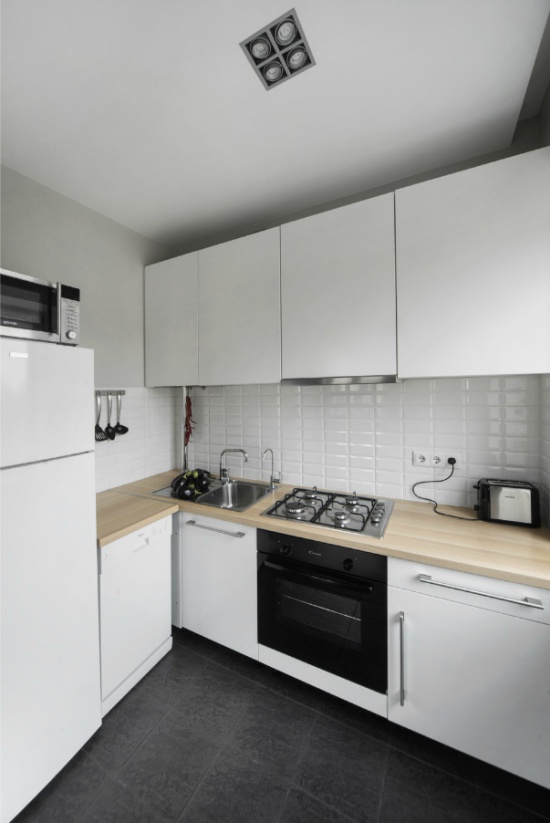In terms of price-quality ceramic tiles - the best option for finishing the floor in the kitchen, and therefore the most popular. Find out how to choose the perfect floor tile by following our customer guide and get some floor design ideas from the selection of interior photos.
The pros and cons of the tiled floor in the kitchen
Ceramic tile has much more advantages than disadvantages:
- Due to its smoothness and antistatic properties, it is very easy to clean and not afraid of aggressive cleaning products.
- May lie in good condition for at least 15 years.
- It tolerates flooding, burning and temperature drops (unlike wood / laminate).
- Allows you to locally repair the floor, replacing only damaged areas.
- Ceramic / tile is cheaper than porcelain, flooring and wood boards, and even more so stone, but it can adequately imitate the texture of natural materials.
- The variety of colors, textures, sizes of tiles and masonry patterns allows you to create a unique floor design and even fix some room flaws.
And here is a list of the minuses of the tile and how to minimize them:
- Ceramics are very cold, so it is desirable to combine it with floor heating system (the benefit of the material has excellent thermal conductivity). You can also tile only the working area, and the dining room to finish with a warmer material - wood. Below the photo shows an example of combined floors with tiles and laminate.

However, you can do even easier and lay on the floor mats and make a habit of moving around the kitchen in slippers.

- Another disadvantage of ceramics is poor sound insulation, which is corrected with an additional sound insulation layer.
- The tile is somewhat traumatic due to its slipperiness and rigidity. Bruises on a tiled floor are more painful than on wooden or linoleum.
- Pottery can crack if you drop something heavy on it, say, a cast iron pan. By the way, the dishes accidentally dropped on the floor will inevitably break.
- Laying tiles is quite troublesome and dirty. It is necessary to accurately calculate the consumption of material, to lay it correctly, and most importantly, to make the base perfectly smooth. After all, if there are voids under the tile, it will surely crack. Therefore, all repair work is best to trust the master-tilers, and not to get down to work himself.
Quality and labeling indicators
How to choose a tile on the floor in the kitchen, which will withstand increased traffic, frequent washing with chemical means and constant temperature drops? Marking on the packaging will help determine the quality of the material.
- For the kitchen, tiles of at least class III on the PEI wear resistance scale or at least class 5 according to GOST will be suitable. Also, increased foot wear can be reported by a foot sign on a shaded background.
- The floor tile can be 1, 2 or 3rd grade.The first grade of tiles allows for only 5 defective tiles per hundred, and the third - 25 or more.
- When choosing a tile for the floor, make sure that it is really outdoor. This will tell you a sign in the form of feet. Wall tiles with a palm sign for facing the floor is not suitable. By the way, floor tiles, on the contrary, can be laid on floors and walls.
- To make the floor scratch as little as possible, choose the tile that has a hardness of at least 7 units on the Mohs scale. Then neither the sand brought from the street, nor the knife that fell on the floor or a piece of glass will damage the surface of the ceramics.
- Which tile is better to choose for the kitchen - glossy or matte? From the point of view of practicality, matte or semi-matte tiles are preferable, since they are more resistant to scratches and abrasion. The main thing is that the matte tiles do not have a pronounced relief and roughness, otherwise it will be difficult to care for it. The glossy tile is very beautiful, easy to clean and visually lightens the space, but, unfortunately, it can have only 5 or 6 points on the Mohs scale, which means it is easily damaged by harder materials - sand, glass and metal.

A single tile for the floor of the kitchen and hallway should be especially scratch-resistant (especially from the sand that accumulates in the hallway) and have at least 7 points on the Mohs scale of hardness
- To the floor in the kitchen was not too slippery, you should choose a tile with a friction coefficient of at least 0.75. By the way, if you prioritize the safety of moving around the kitchen, we advise you to choose a tile slightly rough as in the photo below and with a slight relief. Unfortunately, this coating is somewhat more difficult to maintain than smooth or glossy tiles.

- So that the floor in the kitchen can withstand washing even with the use of aggressive cleaning products, choose the least porous tile with minimal moisture absorption, i.e., AA-labeled tiles.
Of course, the higher the quality, the more expensive the price. As a rule, the price of a good tile without overpayment for the design and brand is from 20 to 36 Euro per square meter.
Sizes and Formats
The shape of the floor tile / ceramic tile is most often rectangular or square.
- The most common sizes are formats: 20 × 20, 25 × 25, 20 × 30, 30 × 40, 33 × 33, 40 × 40 cm and their variations extending from the canons by 1-3 cm. Often there is also a small format 15 × 15 and 10 × 10 cm.

Rectangular tile size 20 × 30 cm in the interior of the kitchen

Custom large tiles in the interior of the kitchen
The format and size of the tile determines not only the appearance of the floor in the kitchen, but also the final cost and complexity of the finish, the amount of waste and cut tiles. Here are a few tips on choosing the size and shape:
- Ideally, the size of the tiles should be such that when laying their trimming is required at a minimum and waste is formed as little as possible. Calculate the required number of tiles and determine the optimal size for your kitchen drawing-layout helps. The simplest calculations and drawings can be done independently, armed with a calculator, exercise book and calculation guide.

An example of the simplest laying tiles
- Calculation of complex layouts is best entrusted to a specialist. The main thing is to provide him with the exact dimensions of the kitchen, taking into account all the features (projections, niches, pipes, etc.), choose several tile options that you like, and decide on the layout pattern. As a rule, the service of a designer-designer is provided free of charge upon subsequent ordering of material.
Having calculated the exact number of tiles, add to this number another 10-15% of the stock. He is required in case of a battle, the discovery of marriage and local repair of the floor in the future. If suddenly the purchased tile is not enough, the risk is high simply not to find a tile of the same tone / caliber.
- Before making a purchase, make sure that all boxes contain the same caliber, that is, the actual size, which may differ from the nominal size by 5-7 mm.The caliber is indicated on the package next to the nominal size, for example, 30 × 30 cm (W288x288 mm) or just an alpha / numeric code as in the photo example below. By the way, such an error is not a marriage, but only a technological feature of the production of ceramics.

To tile lay smoothly, without curved seams and joints, make sure that it has the same caliber
- If the base is uneven, then to finish it is to choose a tile of 10 × 10 cm or 15 × 15. So the floor drops will be less noticeable, and the coating will be very strong. However, it is somewhat more difficult to lay a small tile and keep it clean.
Tile tone
In addition to the caliber, the tone of the tile is also important, that is, the actual shade of the stated color. The fact is that the tone is always slightly different from batch to batch, despite the same color and belonging to the same collection. The difference between tiles of different colors may not seem significant at all, however, after laying, it will most likely become noticeable. The error in shades is still the same feature of the production of ceramics, which manufacturers decide by sorting the material by tone.
Buying a tile or taking delivery of goods to the house, check the matching of the tone on all the boxes. Usually it is indicated next to the caliber in the form of an alphabetic or numeric code.
What to do if the tiles of one tone are not enough? In this case, you should take the tile as close as possible to the main one and lay it where it will be least visible. For example, under the kitchen set, refrigerator or under the table.
Floor design, tile color and installation options
And now let's talk about the most interesting thing - planning the design of the floor covering, choosing the color, texture and pattern of the tile layout. Here are some tips to adopt:
- If a small kitchen, then the tiles laid on the diagonal, herringbone or in the break will help to push the walls apart. Remember that too large tiles can visually “squeeze” an already small space.

An example of the layout of black and white tiles on the diagonal

Floor tiles laid out
- If a narrow kitchen, the tile should choose a rectangular and lay it across the floor.
- On spacious kitchen floor tiles are preferably medium or large in size; small tiles risk getting lost and overloading the interior with a number of seams. However, keep in mind that the larger the tile, the less its strength.
- Tile floor without seams (rectified tiles) - versatile and easy to clean. However, due to the fact that the coating is obtained almost monolithic, it becomes less durable.
- If the kitchen does not have enough natural light, then the warm shade of the floor will be the most organic. Conversely, if the room is sunlit most of the time, the tile is to choose a cold shade, for example, gray or blue.
- Light and medium saturation tiles, oddly enough, much more practical than the dark, for example, black or dark brown. Spots, water droplets, chips and dust on it are almost invisible. However, too light tile has a weak spot - the seams, which quickly get dirty and darken over time.

- Floor tiles should be combined with the walls or other elements of the interior - an apron, kitchen set, and even curtains. For example, the color of the tile can be chosen to match the pattern on the wallpaper or in the same style with an apron as in the interior in the photo below.

The apron and floor of this classic kitchen is tiled with Spanish Vives
- Most often the floor plays the role of a neutral background, which does not interrupt other elements of the interior. But sometimes it is the floor that becomes the main accent, for example, if the tile is bright, with contrasting grout or with a pattern. In this case, it is very important to arrange the rest of the interior rather restrained.
- As a rule, for modern interiors, tile is chosen smooth, monochromatic or imitating wood, stone, reptile skin and other unusual textures.

- For classic kitchens more suitable tile under a square-shaped stone and a small size (from 10 × 10 cm to 30 × 30 cm), tile under a tree (but most often it is already porcelain) or tile with a pattern.

See also the material: How to lay a tile with your own hands.
In case of going to the store
Before going to the store, carefully measure the kitchen, roughly determine the pattern of laying, color and design of the coating as a whole.
- Do not forget to grab a notebook and pen to write down the parameters of the options you liked: article, price, manufacturer’s name and collection, and most importantly, dimensions (the caliber at the planning stage can be ignored). After returning home, carefully consider which tile to choose in size and design, calculate the consumption of material, if possible, make layouts, read reviews and monitor the market. Perhaps, in any online store the tile of the article you need is cheaper.
- And once again we remind you that before making a purchase, you need to recheck the caliber and tone of the dialed boxes yourself, and also to buy material with at least 10% margin.
Photo Gallery
- Gender is relative: choose flooring for the kitchen
- Self-leveling kitchen floor
- All about grouting for tiles - ranking the best manufacturers and a 4-step optional guide
- Cork flooring - 99% ideal floor covering for the kitchen
- Floorboard in the kitchen - all the pros and cons
- Everything about linoleum for the kitchen - compare, choose and lay your own hands
- Porcelain tiles in the kitchen - 99% perfect floor




































 (Rate the material! Already voted:22 average rating: 4,59 from 5)
(Rate the material! Already voted:22 average rating: 4,59 from 5)
The tile in the kitchen looks beautiful. But it is advisable to make floor heating, because the tile itself will be cold.
I have to repair in a one-room apartment and I definitely decided that the kitchen floor would be tiled. Underfloor heating is necessary and not so expensive, and it will turn out, all the more so since the kitchen area is 9 square meters, and it will only be necessary to reheat 1.5 square meters, the rest of the space will be occupied by a refrigerator, stove and furniture))) Only one thing confuses me , the dishes that fell on the tiled floor, not just broken, but scatters into dust ... ...
And we have already made repairs, and first of all we put tiles in the kitchen and in the hallway. As soon we expect replenishment, cleaning with tiles will be much easier and easier.
The tile in the kitchen is my choice! There are much more pluses than minuses. Such a minus as a cold floor, for me personally in the summer is a huge plus. When the temperature is under 35 degrees, it is so nice to walk on a cool tile. And ease of care for such a floor crosses out all the other disadvantages.
We recently made repairs and put tiles on the kitchen floor, we didn’t even consider other options. We chose a solid ceramic granite on the advice of a consultant from the store and didn’t lose it. She is not afraid of strikes and even if she drops any heavy dishes or cracks it will not be easy. It can be washed easily and, if necessary, you can use quite aggressive chemical agents. It is cool to walk barefoot on it, but in summer it is very pleasant in the heat. The choice of tile is very large now, it’s easy to choose a beautiful option, plus practical spine compared with other coatings to the kitchen. I am very pleased with my beautiful tiles!
Caring for a tile needs a minimum, the minuses in the tile are also few and all of them can be fixed, although the problem with a cold floor is not so easy to fix, since the “warm floor” costs a lot of money and not everyone can afford it.
This floor will be most welcome in any kitchen.
Ceramic tiles are easy to keep clean and it will give the kitchen refinement and
you just.
We wanted first, as is customary now, to lay out a laminate in the kitchen, but after reading the article, we decided to opt for a tile with an ornament, and after reviewing many options, opted for a tile of white color with black inserts, the classics never go out of fashion. “Warm floor” and put a small rug near the table or directly under it, so it will be cozier. The main thing is to choose slippers so as not to slip.
I liked the control of the tilers), in terms of maintaining 10% of the level of voids)) It is best to count on the decency of the performers, because watch for each tile - thank you)